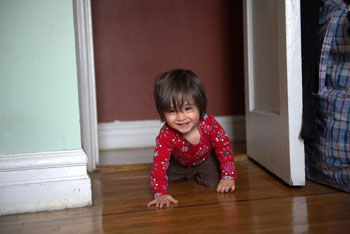
Chapter 11. Integrating Perceptual Information with New Modes of Self-Locomotion
Synopsis


INTEGRATING PERCEPTUAL INFORMATION WITH NEW MODES OF SELF-LOCOMOTION
Estimated Completion Time:
Approximately 5 minutes.
Synopsis:
In this module, Karen Adolph, Ph.D., New York University, discusses her research on the difficulties that infants initially experience in transferring their perceptual learning from one new mode of self-locomotion to the next.
Video
As infants progress from sitting to crawling to cruising to walking, they apparently have to learn anew through experience how to integrate perceptual information relevant to each new mode of moving about the environment. In the following video, Karen Adolph explains this developmental phenomenon and illustrates it with some of her research findings.
Essay Question

1.
Suppose that you are a parent and that you have noticed that your 11-month-old will crawl to the edge of the basement stairs and stop. Would you conclude that your baby has learned about the danger of stairs and that you won’t need to be terribly vigilant when the child learns to walk in the future? Why or why not?
Activity Completed!
Congratulations, you have completed this activity!
You have received a provisional score for your essay answers, which have been submitted to your instructor.